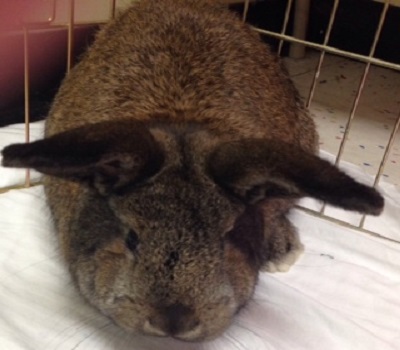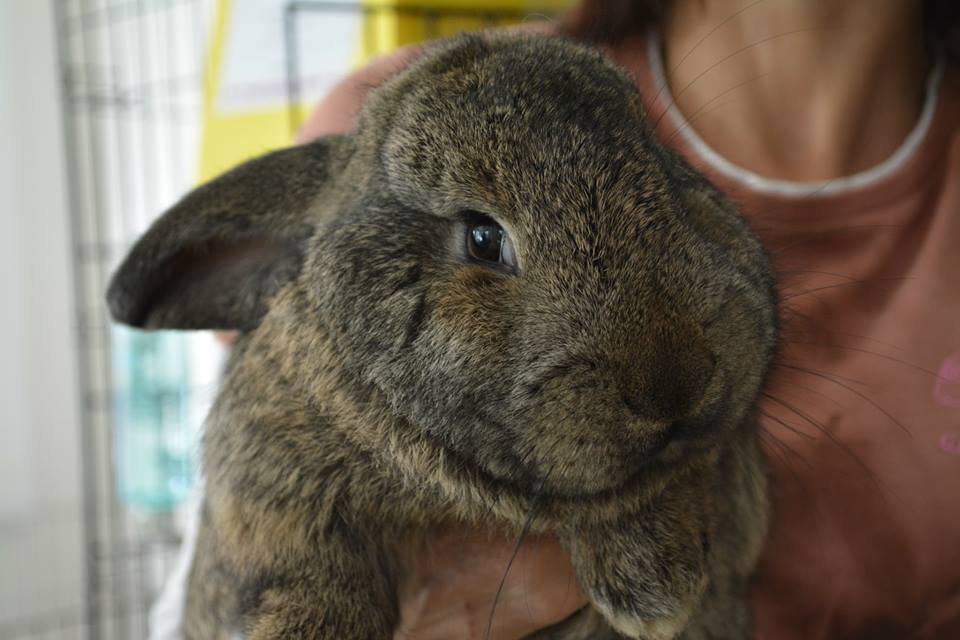Rabbits: A Less Understood Animal (DRAFT): By Coral MacLeod
When I first received this assignment, I was skeptical as to my ability to deliver an interesting enough topic, one that needed telling, but also of enough interest. About eight weeks ago, I had to put down my first pet I had had a relationship with for nine years. She was the sweetest rabbit I probably will ever know: small, silver, gentle, a licker. Whenever I had a bad day and came home, she was there waiting for me, always ready to be petted and fed and cuddle. Helping her out of pain was one of the most heart-wrenching decisions of my life. I still see her eyes at peace looking up so trusting of me even in death I loved her and was doing what was best for her, teary eyed and sobbing, kissing her little head. Although some might think I would have buyers remorse, I was just the kind of person who could not be without the love of a pet. And I had fallen in love with rabbits as a pet. I asked myself the important questions such as did I have time to train a baby rabbit to be litter box trained with all I had to do?
Shortly thereafter, as I sought out a new and right companion, I was delighted to find Jango, a roughly two year old Flemish Lop I gave a real home. His first reaction when I brought him to the apartment was the saddest expression. Such worry and fear. I had rescued him from a harsh meat farm from people who had kicked him (he was afraid of my legs/feet) and many other things, caged, cramped with many other bunnies, Jango had gone through a loving adoption agency who had responsibly neutered him and loved and petted him and he was just at the right time, we were introduced. HE LOVED running round his new carpeted home with TOYS, something he hadn’t had, space, loving discipline, gentleness and patience. I saw him transform from being scared and cringing to doing binkies and race tracking round his space. However, not all rabbits are so fortunate and I would like to introduce you to the reasons why.
What is the plight?
The plight has several aspects. The main plight is lack of education, information distributed beyond niches of small and in between rabbit societies and rescue/adoption agencies. The problem of abuse includes international trade, lack of education in the very educational groups that raise this animal and lack of connection where young and old, writers, filmmakers and networkers can assist in a campaign of awareness.
Ignorance
Many people just see baby rabbits. They don’t see what happens to them after if they are rejected, turned into the ASPCA, and though they had discontinued their humane education department, Petroglyphs website estimates about 3-4 Million rabbits are euthanized per anum.http://www.petroglyphsnm.org/rabbits/plight.html. The RSPCA in an article published in the UK claims that 35,000 rabbits are abandoned per anum.
Abuse & Use Starting out
So abuse is not only verbal, it is physical and emotional, as I saw with my new adopted rabbit. People don’t know where rabbits come from. You think you are getting it from a reputable breeder at the pet store. The problem is that reputable breeder is not clearly defined. A number of bunnies are from farms that the grounds can get flooded and whole clans die or from a very young person in 4H who is learning the basics of breeding but not required to get them their wellness exam at the veterinary clinic.
Meat Farms
Unfortunately, rabbits raised on meat farms can be, as shared by an adoption agency employee, common pets dropped off to places where people mistakenly think the owners just love rabbits. These rabbits are kept in close quarters with other rabbits cramped, physically roughly handled, not cared whether hit, kicked or otherwise. Not many restaurants serve rabbit advertised on Google, but there are places on the east coast in Philadelphia and New York. Places such as: Saro Bistro, Glasserie, Café China, Al Mar, The Marrow, I Sodi, Maialino, Marlow & Sons. I am a rabbit pet owner and will not eat the meat, but I do applaud lack of wastefulness in the culinary world and realize not all restaurants deal with the irreputable meat farms and use all they can when they purchase.
Meat farms are also a problem many do not know of much. Some people think it is funny to joke about cooking pet rabbits to rabbit owners and I cannot state just how angry that makes us. I have heard it so many times, that I want to just turn around to the next person who cracks it and ask them how their children taste. No one jokes about cooking dogs or cats. There are a few meat farms that are “reputable” mainly selling overseas to European countries. One of the largest in California, devils gulch ranch, is located in Marin county and news articles within the past four years, particularly last and this year, the news in the UK, CNN & ABC is drawing attention to the plight of ignorance. One site:http://www.freedomforfarmedrabbits.com posted “global rabbit meat consumption in 2004 was 1.1 million tonnes. Approximately half this amount comes from meat farms.” That is equal to 44,000 eighteen wheelers. Half of that provided by meat farms would equal 22,000 eighteen wheelers of rabbit meat.
The meat is widely renowned for its health aspect of the omega-3 oils and efficiency aspect of being able to get 5-6 pounds off one animal, as ABC News article claims, http://abcnews.go.com/Business/bunny-rabbit-trendy-meat/story?id=23644934 that “using the same amount of food and water a cow needs to produce a pound of meat.” Unfortunately, most meat farms house the rabbits in a wire mesh cage to cut costs, but this wire cage bottom can make rabbits’ feet sore and lead to sores and infection.
Testing
According to (SITE*), an estimated“245, 786 rabbits are tested annually” Of course I have already mentioned their use briefly in testing cosmetics and other drugs. The third kind of abuse/use that rabbits have the misfortune to bear is that of the fashion industry. Of recent, in the past year, I recall reading a abhorrent article about several of the top companies hurrying international assembly lines for their fur inclusive collections of clothes and instead of gently extracting the undercoat, they yanked it from them.
According to Peta and other sources, including Professional Laboratory, Research Services, Inc., andhttp://ori.hhs.gov/education/products/ncstate/rabbit.htm tell of the unnecessary treatment and abuse of rabbits despite new methods and alternatives available: “Non-animal methods for raising ticks have been available since the mid-90’s.” Some say that alternatives for the Draize test have been in process since the 70s. They are still used for the Draize eye irritancy test, having such things as dishwashing or drain cleaner put on their eyes*(include where from info). Rabbits are also used to test your lipstick, mascara, shampoo and cologne and birth defects. (other small animals like rats and guinea pigs are as well unfortunately also lab animals.) The top ten companies that need the pressure put on them are: Johnson & Johnson, Loreal/Maybelline, Proctor & Gamble, Clorox, Estee Lauder (Michael Kors), Church & Dwight, Dial, Revlon, Unilever (Vaseline), Walgreens. It was not hard to find three websites with a whole list of brands that did not test on animals:
http://www.mediapeta.com/peta/PDF/companiesdonttest.pdf
http://veganrabbit.com/list-of-companies-that-do-not-test-on-animals/
http://www.mybeautybunny.com/cruelty-free-brands/
And if you are thinking, oh, well testing for birth defects is ok or understandable, many have a horrible short life of being penetrated with male rabbit penises, humans force feeding them, then they are only killed along with their kits inside them, and the baby rabbits cut out to be examined. As for other implantation’s, they are not put completely under, but only offered local anesthetic with pictures that will make you lose your appetite.
Fashion
To us, it all, even if we love animals, seem a bit distant. Yet, remind people of when they get up in the morning and their hair is tangled and they cringe at remembering that feeling of having a knot in their hair, unbrushed if accidentally or intentionally yanked. The article was quite specific. Most people do not know rabbits make sounds. They do. They make a “chunnering noise” close to equal of what cats purr would be, when they’re happy and content, whimper when their scared, scree as a sign of dominance, chew on cage bars, hiccup, sneeze and snore adorably, and scream when they’re in pain. It’s hard to imagine a bunch of countless rabbits crying out in pain. That sort of scenario we leave to the film screens for even human pain.Http://arzone.ning.com/profiles/blogs/rabbit-fur#sthash.BZVMfA35.dpufoffers the statistic that 30-40 rabbits are needed to make just one fur coat. The breeds that popped up in my research are prized as Rex or Orylag breeds of rabbit and it is estimated that (*SITE) “One billion rabbits are killed each year for their skins.”
Prohibition Housing
The other problem is housing rabbits. If you have a home, you’re better off, but if you rent an apartment, depending on the city, of course, but I lived in San Jose for 8-9 years. In all my time there, I found one of the TWO apartments in the huge city with several counties with the area that would even be happy to care for rabbits. The one I ended up with was because they were happy to have my rent money, the other I considered moving to, the owner had a rabbit and was educated/fine with the pets. All the others complained of three things: they would smell, they would chew, they would be noisy. People did not accept a little extra money, a written agreement, nothing. Cats smell more than rabbits. Both are/can be litter box trained. (Statistic). Unlike guinea pigs (similar size pets), they are incredibly quiet and they are both intelligent and full of personality.
It is debatably $400-730 to keep the rabbit you choose happy and healthy. Unfortunately, true health food for rabbits such as “Nature’s Benefits” was discontinued because feeding healthy food without chemicals and food coloring supposedly was just not popular enough. Other brands such as Pet Mountain or Vita Kraft are closer to such healthy standards, but the health of rabbits in this arena as well is just not cared enough by enough rabbit owners. There lastly is the list of rabbit knowledgeable clerics/vet clinics: http://rabbit.org/vet-listings/. It lists all 50 states. However, I noticed that only 48 out of the 50 states have rabbit vets and big states such as South Dakota only had one listing.
Travel
The other prohibition of rabbits is travel. People are able to bring their dog or cat on an airplane in a carrying case in first class, but when one broaches bringing a rabbit, people get all in an uproar. People start making the excuse of allergies. Although many rabbits probably are shipped as babies to different parts of the USA now that commerce has expanded to the internet, they should not be exposed to the loud noise of the engines, which can deafen them, harm their hearing (Statistic of rabbit hearing to ours). Interestingly, there are advertised pet friendly airlines for such as rabbits, which include: Areosvit, Airbaltic, Air Europa, Alaskan Airlines, Al Nippon, Copa, Czech, Delta, Emirates, EVA, Finnair, Frontier, Japan, Jet Airways (India), Nok, United Air, & West Jet found at http://wabbitwiki.com/Rabbit-Friendly_Airlines
However, the mode of travel better option for them, the trains and busses, the major transcontinental and big name in state corporations such Amtrak, Greyhound, Mega Bus Gold, Bolt Bus, Lux Bus, VA Moose Bus, Tripper Bus, Caltrain, Metra Rail, Red Coach & NICDT are quite unyielding of ANY pets with the exception of guide dogs. The only ones thus far I have found are BART (within CA), the MARC train (Maryland), and VRE. Their rules are absolute and uneducated about the needs of rabbits, which is a shame when they have the potential to be a mode of unstressful travel option for both owner and small furry pets.
Another problem associated with shipping and travel arose with the internet pet websites, people can order outside the country. However, rabbits in the UK or other countries might have no way of guarantee of veterinary health and come with different diseases and again educated the same adoptee I spoke with before getting my third rabbit in my life, there is disease, rabbits have medication in the UK, but it is not available even here in the USA, even though it is highly contagious and can wipe out rabbits and deadly, works very fast. It is hard to find a vet knowledgeable in exotic pet health, from specifically needed anesthesia to trimming nails, shaving too long teeth.
Promotion Through The Arts
Encouragingly, there are efforts on the internet, on Facebook, networking education, individuals and adoption agencies who are making an effort to promote, help and inform. Even I didn’t know September 26 is international rabbit day. Yet, there are still too many rabbits put into shelters, raised at meat farms and don’t reach a long lifespan of 8-15 years. I see ways I can help as a film major. Recounting the numbers given in this article, you have well over 1,004,245,786 rabbits who die each year in all these industries, compared monolithically to the number of adoption agencies fighting on these bunnies behalf. To me, that is heart wrenching. As for what I can do, I can write this article. Now, what you can do with this information and your talents, I look forward and hope to see in helping these wonderful critters so full of love and personality that sweetly haunt our dreams of chocolate and new life around a holiday that is centered thematically of life, yet we have not given life nor sweet dreams to the very animals we find that warm our hearts.
![F.U.R [ Friends of Unwanted Rabbits ]](http://www.friendsofunwantedrabbits.org/wp-content/uploads/2013/08/FUR-website-logo.png)



